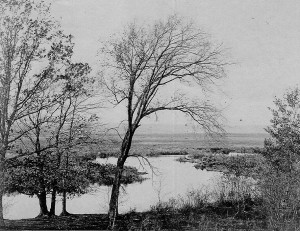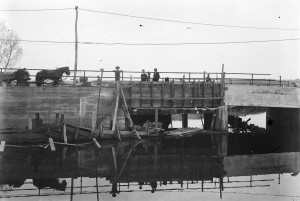True Tales: Our river through the meadows
By George T. ComeauAt the edge of my property is a small stream, the Pequit Brook, and its source is the Reservoir Pond past Pequitside Farm. Living on a brook is an amenity that allows for plenty of opportunities to observe wildlife and the marking of seasons. Over time we have come to know the animals that inhabit our small corner of Canton. We have watched muskrats, ancient snapping turtles, the great blue heron, red-tailed hawks, numerous rabbits, fox, and all manner of mallards. The jewelweed and grass is abundant and the meadows are filled with red-winged blackbirds come fall. The winter gives way to woodpeckers and more flocks of waterfowl, even an occasional fisher cat and coyote. So abundant is the wildlife that at times we feel as though we live in a suburban wildlife preserve.

The Neponset River as it winds through the Fowl Meadows circa 1890. (Courtesy of the Canton Historical Society)
The Pequit Brook winds down through Sherman Street and eventually finds it way to the East Branch of the Neponset River. And the Neponset in turn finds its way to the Massachusetts Bay. Nobel laureate Hermann Hesse wrote: “How he loved this river, how it enchanted him, how grateful he was to it! In his heart he heard the newly awakened voice speak, and it said to him: Love this river, stay by it, learn from it. It seemed to him that whoever understood this river and its secrets, would understand much more, many secret, all secrets.”
So, what secrets does the Neponset River hold for us? To begin with, the name itself is somewhat of a secret. Of course it is an Indian name, and when the famous Algonquin scholar G. Hammond Trumbull was asked, he vainly endeavored to learn the significance of this name. “That word in all its forms of Naponset — Aponset, or Neponset defies analysis.” Many have surmised it means “river that flows through meadows.” This would be a fair description, since it travels through nearly seven miles of beautiful grassy meadows — the Fowl Meadows, in fact. So attractive to the early settlers were these grasses that the seeds were harvested and exported to Europe to produce the same luxurious grasses there.
Overall, the Neponset River travels more than 29 miles, starting at Gillette Stadium and ending near the gas tanks along the Southeast Expressway. The historical significance reaches back more than 10,000 years. Imagine the scene as Paleolithic man camps near the river right here in what would become Canton. Archeologists, both amateur and professional, have recovered over 2,600 Clovis spear points as well as mastodon tusks and caribou bones. The site, called Wamsutta, has been studied for more than 20 years. What were once the shores of a Pleistocene Lake seems to have been an important workshop of sorts where tools were made and wildlife harvested.
The recorded history of the Neponset starts around 1619, when Native Americans would use the river as a route to trade furs, largely muskrat and beaver. The wildlife was amazing. An apt description of what the Neponset River must have been like is found in a quote in a book written by Edward Johnson in 1628, entitled Wonder Working Providence: “The cod-fish, holybut and bass, do sport the rivers in, and alewives with their crowding sholes in every creek do swim.” The alewives in particular caused major legal battles in colonial Massachusetts, and the early records record heated arguments between mill owners who would dam and control the river and the fishermen whose livelihood was constantly in jeopardy as industry advanced. The argument to restore the fish and breach the dams still continues today.
The industrial growth as a result of this power source is nothing short of amazing. The second dam in the new world was constructed by Israel Stoughton, who was given permission to build a grist mill in what was known as Dorchester Plantation in 1634. What came next was a series of “firsts.” In 1640 shipbuilding began at what was known as Gulliver’s Creek (yes, there is a connection to Jonathan Swift’s Gulliver’s Travels). Soon sawmills, a snuff mill, powder mills, tanneries, slitting mills, and fulling mills began to rise near the banks of the Neponset.

Construction of the bridge over the Neponset River to Norwood, April 1915. (Courtesy of the Canton Historical Society)
Several of the most famous mills in America were started along the Neponset. In 1728, the first paper mill was erected. In 1765, Dr. James Baker founded a chocolate mill in Milton, which would become the world-famous Baker’s Chocolate Company. Closer to home, the Canton River, which fed the east branch of the Neponset, was home to James Beaumont’s Neponset Mills, where arguably the first piece of cotton cloth in America was made in 1802. In 1801, Paul Revere made his home here in Canton and erected his copper rolling mill (another first in the nation) along the tributary branch of the Neponset.
To get the best view of the Neponset River in Canton, take a drive down Dedham Street, and as you pass the old Cumberland Farm Complex take a left onto the property owned by George and Nancy Bates. The Bates still own a small portion, but the largest is now owned by the Trustees of Reservations (TTOR). When you come here you are visiting Signal Hill. This is perhaps an oft-overlooked location from where you can “overlook” the Neponset Valley. The hike is easy and the views are entirely rewarding. The boundary line between Canton and Norwood follows the center of the river.
In 2002, George and Nancy Bates sold the development rights of 135 acres of upland and swamp to the then MDC. Signal Hill is the result of a 111-acre gift given to TTOR in 2005 by the Bates. While it is called Signal Hill because it once held signals to assist in the navigation of planes to the Norwood Airport, it might have been more historically named.
Historically speaking, this area was generally known as Taunt’s Farm. At one time there were two prominent hills here, each about 120 feet high. Turtle Hill (now known as Signal Hill) and Pillion Hill, which was removed for fill used in Boston’s Back Bay. What is left, the single hill, affords an easily accessible view of Boston. The first settlers here were John and Hepsibah Taunt. Likely settled in 1758, this land was rich with nutrients and made the perfect home for this private in the Stoughton Militia. Three generations of Taunts would live on this land until around 1844. Eventually Elisha White would buy the property, and by the 1930s the land would become part of the land acquisition program for the Canton Airport.
(Click on Page 2 below to continue reading)
Page 1 Page 2
Short URL: https://www.thecantoncitizen.com/?p=6774










